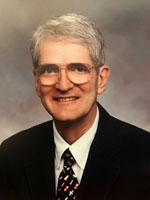Because of a lapse in government funding, the information on this website may not be up to date, transactions submitted via the website may not be processed, and the agency may not be able to respond to inquiries until appropriations are enacted. The NIH Clinical Center (the research hospital of NIH) is open. For more details about its operating status, please visit
cc.nih.gov. Updates regarding government operating status and resumption of normal operations can be found at
opm.gov.
Former Fogarty Director Dr. Phillip E. Schambra dies
September / October 2011 | Volume 10, Issue 5

Former Fogarty Director
Dr. Phillip E. Schambra.
Former Fogarty Director Dr. Phillip E. Schambra, who led the Center from 1988-98, died on Sunday, Sept. 11, 2011. During his tenure, the Center witnessed tremendous growth as its budget doubled and its research training portfolio dramatically expanded.
Under Schambra's leadership, Fogarty's flagship AIDS International Training and Research Program (AITRP) flourished and grew substantially. As a result of AITRP, scores of scientists have been trained throughout the developing world, saving countless lives from the scourge of HIV/AIDS and facilitating many breakthroughs in prevention, therapy and care. This groundbreaking program provided the model for many of the Center’s activities that followed. Based on AITRP’s success and Schambra’s personal commitment to addressing the health problems in low- and middle-income countries (LMICs), the Center dedicated its extramural program to research and research training involving LMICs.
In addition to AITRP, Schambra guided the development of five Fogarty funding programs that encourage international collaborations; increase opportunities for minority scientists; and build developing country expertise in environmental and occupational health science, population studies and emerging infectious diseases. During his decade at the helm, the Center also helped develop an initiative to address biodiversity conservation and promote sustained economic activity through drug discovery from natural products. That innovative program continues to flourish today, thanks to the partnership he forged with the National Science Foundation, Department of Agriculture, and several NIH institutes.
Schambra also served as a key member of the White House Committee on Science, Engineering and Technology, which developed U.S. science policies to engage the emerging European Union and Russian Federation.
After receiving his bachelor's in physics from Rice University, Schambra earned a Ph.D. in biophysics at Yale, where he worked with a large number of foreign postdocs, helping to spur his interest in international relations. Following a fellowship in Germany, he conducted research and taught at the Donner Laboratory at the University of California, Berkeley. He then moved to Washington to pursue a different type of science career. After training as an NIH grants officer, he spent three years at the White House budget office as examiner for the NIH budget, working closely with NIH leadership as funding for cancer research was doubled. He also suggested NIH develop a program to train minority scientists, which led to the establishment of the Minority Biomedical Research Support Program.
In 1974, he returned to NIH as associate director for interagency programs at NIEHS. His Fogarty career began in 1980, when he was named chief of the then International Coordination and Liaison Branch. From 1984 to 1988, on loan from Fogarty, he was science attaché at the U.S. Embassy in India. He was named Fogarty director that year and served until 1998, when he retired with 30 years of government service.
More Information
To view Adobe PDF files,
download current, free accessible plug-ins from Adobe's website.